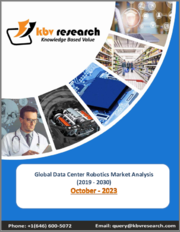
|
시장보고서
상품코드
1364044
세계의 데이터센터 로봇 시장(2016-2030년) : 구성요소(소프트웨어, 서비스, 하드웨어), 산업(IT&통신, 은행/금융서비스/보험(BFSI), 교육, 헬스케어, 부동산, 리테일&이커머스, 기타), 지역별 기회 및 예측Data Center Robotics Market Assessment, By Component [Software, Service, Hardware], By Industry Vertical [IT & Telecom, BFSI, Education, Healthcare, Real Estate, Retail & E-commerce, Others] By Region, Opportunities and Forecast, 2016-2030F |
||||||
세계 데이터센터 로봇 시장 규모는 2022년 85억 2,000만 달러에서 예측 기간 동안 17.7%의 CAGR을 나타내고, 2030년 314억 달러 규모까지 성장할 것으로 예상됩니다.
IT-통신 분야 클라우드 서비스 확산으로 시장 성장 촉진
세계 데이터센터 로봇 시장에서는 IT 및 통신 부문의 클라우드 서비스 도입이 눈에 띄게 증가하고 있습니다. 이러한 추세는 확장성 강화, 비용 효율성, 간소화된 접근성 등 클라우드 기술의 매력적인 장점에 힘입어 더욱 가속화되고 있습니다. 업계가 민첩한 운영, 원활한 원격 협업, 혁신적인 솔루션을 추구함에 따라 클라우드 서비스 통합은 매우 중요해지고 있습니다. 이러한 급증은 업계가 클라우드 기술을 매우 중요한 원동력으로 인식하고 있으며, 디지털 전환의 요구에 맞추어 역동적으로 진화하는 기술 환경 속에서 데이터센터 로봇의 역량을 강화하는 데에 클라우드 기술을 활용하고 있음을 보여줍니다.
AI가 시장 성장을 가속합니다.
AI 기술의 등장은 세계 데이터센터 로봇 시장에 큰 영향을 미치고 있으며, AI를 통해 데이터센터 로봇은 자동화, 예측 유지보수 및 실시간 분석 작업의 역량을 강화할 수 있게 됐습니다. 이러한 AI 기반 발전은 데이터센터의 효율성을 높이고, 다운타임을 줄이며, 리소스를 보다 효율적으로 활용할 수 있도록 돕고 있습니다. 또한, AI 기반 로봇공학은 지능형 의사결정을 위한 길을 열어 데이터센터가 고도로 상호 연결된 환경에서 변화하는 수요와 복잡성에 빠르게 적응할 수 있도록 지원하며 시장 성장을 가속하고 있습니다.
로봇 프로세스 자동화(PRA) 도입률 확대에 따른 사업 기회 확대
세계 데이터센터 로봇 시장에서 PRA 도입률이 크게 증가하고 있습니다. 이러한 증가는 RPA가 복잡한 데이터센터 업무를 자동화하여 업무 속도, 정확성 및 비용 효율성을 향상시킬 수 있는 능력에 기인합니다. 또한, RPA의 반복적인 프로세스 관리 능력과 기존 시스템과의 호환성이 RPA의 통합을 촉진하고 있습니다. 또한, 데이터센터 부문의 조직들은 자원 배분을 강화하고, 오류를 줄이며, 전반적인 효율성을 향상시키기 위해 RPA를 활용하고 있습니다. 이러한 도입 확대는 RPA가 데이터센터 운영의 미래를 형성하고 기술 중심의 환경에서 민첩성과 혁신을 촉진하는 데 있어 매우 중요한 역할을할 것임을 반영합니다.
북미, 세계 데이터센터 로봇 시장 성장 견인
북미가 종합적으로 시장 성장을 주도하고 있으며, 이러한 추세는 앞으로도 지속될 것으로 예상됩니다. 북미의 선두는 탄탄한 기술 인프라, R&D에 대한 대규모 투자, 미국 내 자동화 도입의 조기 도입에 기인합니다. 이러한 요인들은 기술 혁신과 시장 수요를 촉진하고, 데이터센터 로봇 기술의 통합과 발전에 유리한 생태계를 조성하고 있습니다.
세계 데이터센터 로봇(Data Center Robotics) 시장을 조사했으며, 시장 정의와 개요, 시장 규모 추이 및 예측, 각종 부문별-지역별 상세 분석, 산업 구조, 시장 성장에 영향을 미치는 요인 분석, 사례 조사, 경쟁 구도, 주요 기업 프로파일 등의 정보를 정리하여 전해드립니다.
목차
제1장 조사 방법
제2장 프로젝트의 범위와 정의
제3장 COVID-19가 세계의 데이터센터 로봇 시장에 미치는 영향
제4장 주요 요약
제5장 고객의 소리
- 제품과 시장 인텔리전스
- 정보원
- 구입 결정에서 고려되는 요소
- 수요 및 공급 메커니즘
- 안전 규제 검토와 이해
- 법령 준수 적용
- 기존 사용자 또는 구입 예정자
제6장 세계의 데이터센터 로봇 시장 전망
- 시장 규모와 예측
- 컴포넌트별
- 소프트웨어
- 서비스
- 하드웨어
- 산업별
- IT&통신
- 은행/금융서비스/보험(BFSI)
- 교육
- 헬스케어
- 부동산
- 소매 및 E-Commerce
- 기타
- 지역별
- 북미
- 유럽
- 남미
- 아시아태평양
- 중동 및 아프리카
- 기업별 시장 점유율
제7장 세계의 데이터센터 로봇 시장 전망 : 지역별
- 북미
- 유럽
- 남미
- 아시아태평양
- 중동 및 아프리카
- 시장 규모와 예측
- 컴포넌트별
- 산업별
- 국가별
제8장 시장 매핑
제9장 거시환경·산업 구조
- PESTEL 분석
- Porter의 Five Forces 분석
제10장 시장 역학
- 성장 촉진요인
- 성장 억제요인(과제·제약)
제11장 주요 기업 상황
- 시장 리더 주요 5개사 경쟁 매트릭스
- 시장 리더 주요 5개사 시장 매출 분석
- 인수합병(M&A)·합작투자(해당하는 경우)
- SWOT 분석(참여 5사)
- 특허 분석(해당하는 경우)
제12장 가격 분석
제13장 사례 연구
제14장 주요 기업 전망
- ABB Ltd.
- Cisco Systems Inc.
- Huawei Technologies Co. Ltd.
- Microsoft Corporation
- BMC Software Inc.
- ConnectWise LLC
- NTT Communications
- Hewlett Packard Enterprise Development LP
- Rockwell Automation Inc.
- Siemens AG
제15장 전략적 제안
제16장 당사에 대해·면책사항
LSH 23.10.25Global data center robotics market has witnessed substantial expansion in recent times and is anticipated to sustain a robust growth trajectory in the upcoming years. Following its attainment, the market's estimated value in 2022 is USD 8.52 billion, and the market is projected to achieve a valuation of USD 31.4 billion by 2030. This projection highlights a CAGR of 17.7% from 2023 through 2030.
Data center robotics bring automation, efficiency, and reliability to data management. They enhance resource utilization, reduce human error, lower operational costs, and ensure 24/7 uptime, resulting in improved data center performance and productivity. Factors impacting the global data center robotics market include technological advancements, increasing data center complexity, demand for efficient resource management, cost savings, and the pursuit of streamlined operations, thereby driving substantial growth and adoption of robotics in the sector.
One of the most prominent examples of technological advancements is the development of autonomous robotic systems. As per Data Center Magazine, by means of self-driving technology, these robots autonomously map & navigate data centers to provide real-time sensor data. It in turn, permits them to make a comparison between the already established norms and the current patterns so that any distinction, if spotted, can be escalated for human analysis. Hence, it can be delineated that autonomous robots can provide the decision-makers with accuracy, multidisciplinary intelligence, and speed which is much more than a static camera's capabilities.
Uptake of Cloud Services in the IT & Telecom Sector Augments Market Growth
The Global data center robotics market has seen a notable uptick in adopting cloud services in the IT and telecom sectors. This trend is propelled by the compelling benefits of cloud technology, including enhanced scalability, cost-efficiency, and streamlined accessibility. As the industry strives for agile operations, seamless remote collaboration, and innovative solutions, the integration of cloud services has become pivotal. This surge underlines the sector's acknowledgment of cloud technology as a pivotal enabler, aligning with the demands of digital transformation and bolstering the capabilities of data center robotics within a dynamically evolving technological landscape.
As per Zippia, cloud services adoption has seen a substantial increase in the United States, with approximately 94% of organizations employing them. Moreover, nearly 67% of enterprise infrastructure has transitioned to cloud, and approximately 92% of businesses are either implementing or planning a multi-cloud strategy.
Artificial Intelligence is Propelling the Market Growth
The emergence of Artificial Intelligence technologies has significantly impacted the global data center robotics market. AI has enabled data center robots to enhance their capabilities in automation, predictive maintenance, and real-time analytics tasks. These AI-driven advancements have led to increased efficiency, reduced downtime, and better resource utilization within data centers. Moreover, AI-powered robotics have paved the way for intelligent decision-making, enabling data centers to adapt swiftly to changing demands and complexities in a highly interconnected environment, fueling market growth.
For example, the United States based Data Center, Frontier delineated that in recent months, there has been substantial excitement surrounding AI, a technology poised to bring transformative changes across various industries, some of which are unforeseeable. In the realm of data centers, AI is anticipated to have a significant impact, yet specific applications and advancements are still in the process of development.
Rise in the Adoption Rate of Robotic Process Automation to Cater Extensive Opportunities
Global data center robotics market has witnessed a substantial rise in the adoption of robotic process automation. This surge is attributed to RPA's capacity to automate complex data center tasks, improving operational speed, precision, and cost-effectiveness. Moreover, RPA's ability to manage repetitive processes and its compatibility with existing systems have driven its integration. Furthermore, organizations within the data center sectors increasingly leverage RPA to enhance resource allocation, mitigate errors, and elevate overall efficiency. This escalating adoption reflects RPA's pivotal role in shaping the future of data center operations, fostering agility and innovation in a technology-driven landscape.
As per Flobotics, around 80% of the financial leaders have already used or are planning to use RPA, and 78% of those who have already implemented RPA anticipate a substantial increase in their RPA investments over the coming three years.
North America is Leading the Growth of the Global Data Center Robotics Market
North America comprehensively leads the market growth and is expected to do so over the years. North America's leadership in the growth of the global data center robotics market is attributed to its robust technological infrastructure, substantial investments in research and development, and early adoption of automation in the United States. These factors have facilitated innovation, market demand, and the creation of a favorable ecosystem for integrating and advancing data center robotics technologies.
For example, in May 2023, Reno Gazette Journal, revealed that Novva Data Centers, located in Utah and specializing in colocation data centers, constructed its latest facility at the Tahoe Reno Industrial Center, incorporating the use of robotic dogs. Notably, the facility's security measures were intriguing. Alongside 24-hour monitored perimeter gates, Novva Tahoe Reno employed autonomous aerial drones and robotic dog surveillance. The robotic dog would verify the occupants through facial scanning and recognition and oversee the temperatures to ensure accurate data storage.
Government Initiatives
Government initiatives play a crucial role in the data center robotics market. They provide essential support and direction for research, development, and adoption of robotics solutions. Such initiatives foster innovation, investment, and collaboration between industry and government bodies, ensuring alignment with regulatory frameworks and technological advancements. By promoting standards, training, and funding opportunities, governments can accelerate the growth of the data center robotics market, enhancing its efficiency, sustainability, and overall contribution to the economy.
For example, in December 2022, the Japanese government supported NTT Data, concluding a pivotal trial involving a unique robot within a data center environment. The achievement has prompted the company to introduce the robot across its 15 Japanese facilities, thereby preparing it for commercial use. The deployed robot, resembling a torso on wheels, comes furnished with arms, basic grippers, and an array of sensors for tasks like remote monitoring and inspections. Trials, conducted at the Shinagawa Data Center from August to November 2022, demonstrated reductions in work hours and facilitated remote operations.
Impact of COVID-19
The global data center robotics market underwent significant changes due to the COVID-19 pandemic, impacting its pre- and post-COVID phases. Before the pandemic, the market was gradually acknowledging the potential of robotics in improving efficiency, reducing human involvement, and enhancing data center management. However, with the onset of COVID-19, the industry experienced a rapid transformation. Lockdowns exposed vulnerabilities in traditional setups, emphasizing the need for adaptable solutions. It led to increased adoption of robotics for tasks such as maintenance, security, and sanitation, thereby reducing human interaction and ensuring uninterrupted operations. Moreover, despite initial supply chain disruptions, the post-COVID period saw a surge in robotics integration, driven by the understanding that automation can mitigate future risks. The market is witnessing increased investments, innovations, and a shift toward remote monitoring. This shift is set to shape the future of the data center robotics market, ushering in an era of improved efficiency and resilience.
Key Players Landscape and Outlook
Significant advancements are occurring in the global data center robotics market, as prominent industry participants are concentrating on broadening their operations across extensive geographical areas through substantial investments. Moreover, this evolution highlights the market's dedication to harnessing advanced technologies to enhance data center robotics practices on a global scale.
In June 2023, NTT Corporation inaugurated a hyperscale data center campus in Chennai, coinciding with deploying the Myanmar-Malaysia-Singapore-India Transit (MIST) subsea cable system in the same location. With committed USD 150 million to the facility, the company anticipates an additional investment of USD 150 million in the subsequent phase.
On March 2023, ABB Ltd. announced that it would expand its robotics factory in the United States. ABB has decided to invest a hefty amount of USD 20 million to facilitate its robotic industry production at its existing Auburn Hills facility to strengthen its leadership with the United States. Moreover, this growth will lead to the establishment of 72 new highly skilled jobs in the region.
Table of Contents
1. Research Methodology
2. Project Scope & Definitions
3. Impact of COVID-19 on Global Data Center Robotics Market
4. Executive Summary
5. Voice of Customer
- 5.1. Product and Market Intelligence
- 5.2. Sources of Information
- 5.3. Factors Considered in Purchase Decisions
- 5.3.1. Overall Expenses
- 5.3.2. Facility Requirement
- 5.3.3. Costs
- 5.3.4. Security Concerns
- 5.3.5. Efficiency
- 5.3.6. Scalability
- 5.3.7. Compliance Support
- 5.4. Demand and Supply Mechanism
- 5.5. Consideration and Understanding of Safety Regulations
- 5.6. Application of Legal Compliances
- 5.7. Existing User or Intended Purchaser
6. Global Data Center Robotics Market Outlook, 2016-2030F
- 6.1. Market Size & Forecast
- 6.1.1. By Value
- 6.2. By Component
- 6.2.1. Software
- 6.2.2. Service
- 6.2.3. Hardware
- 6.3. By Industry Vertical
- 6.3.1. IT & Telecom
- 6.3.2. BFSI
- 6.3.3. Education
- 6.3.4. Healthcare
- 6.3.5. Real Estate
- 6.3.6. Retail & E-commerce
- 6.3.7. Others
- 6.4. By Region
- 6.4.1. North America
- 6.4.2. Europe
- 6.4.3. South America
- 6.4.4. Asia-Pacific
- 6.4.5. Middle East and Africa
- 6.5. By Company Market Share (%), 2022
7. Global Data Center Robotics Market Outlook, By Region, 2016-2030F
- 7.1. North America*
- 7.1.1. Market Size & Forecast
- 7.1.1.1. By Value
- 7.1.2. By Component
- 7.1.2.1. Software
- 7.1.2.2. Service
- 7.1.2.3. Hardware
- 7.1.3. By Industry Vertical
- 7.1.3.1. IT & Telecom
- 7.1.3.2. BFSI
- 7.1.3.3. Education
- 7.1.3.4. Healthcare
- 7.1.3.5. Real Estate
- 7.1.3.6. Retail & E-commerce
- 7.1.3.7. Others
- 7.1.4. United States*
- 7.1.4.1. Market Size & Forecast
- 7.1.4.1.1. By Value
- 7.1.4.2. By Component
- 7.1.4.2.1. Software
- 7.1.4.2.2. Service
- 7.1.4.2.3. Hardware
- 7.1.4.3. By Industry Vertical
- 7.1.4.3.1. IT & Telecom
- 7.1.4.3.2. BFSI
- 7.1.4.3.3. Education
- 7.1.4.3.4. Healthcare
- 7.1.4.3.5. Real Estate
- 7.1.4.3.6. Retail & E-commerce
- 7.1.4.3.7. Others
- 7.1.5. Canada
- 7.1.6. Mexico
- 7.1.1. Market Size & Forecast
All segments will be provided for all regions and countries covered:
- 7.2. Europe
- 7.2.1. Germany
- 7.2.2. France
- 7.2.3. Italy
- 7.2.4. United Kingdom
- 7.2.5. Russia
- 7.2.6. Netherlands
- 7.2.7. Spain
- 7.2.8. Turkey
- 7.2.9. Poland
- 7.3. South America
- 7.3.1. Brazil
- 7.3.2. Argentina
- 7.4. Asia-Pacific
- 7.4.1. India
- 7.4.2. China
- 7.4.3. Japan
- 7.4.4. Australia
- 7.4.5. Vietnam
- 7.4.6. South Korea
- 7.4.7. Indonesia
- 7.4.8. Philippines
- 7.5. Middle East & Africa
- 7.5.1. Saudi Arabia
- 7.5.2. UAE
- 7.5.3. South Africa
8. Market Mapping, 2022
- 8.1. By Component
- 8.2. By Industry Vertical
- 8.3. By Region
9. Macro Environment and Industry Structure
- 9.1. PESTEL Analysis
- 9.1.1. Political Factors
- 9.1.2. Economic System
- 9.1.3. Social Implications
- 9.1.4. Technological Advancements
- 9.1.5. Environmental Impacts
- 9.1.6. Legal Compliances and Regulatory Policies (Statutory Bodies Included)
- 9.2. Porter's Five Forces Analysis
- 9.2.1. Supplier Power
- 9.2.2. Buyer Power
- 9.2.3. Substitution Threat
- 9.2.4. Threat from New Entrant
- 9.2.5. Competitive Rivalry
10. Market Dynamics
- 10.1. Growth Drivers
- 10.2. Growth Inhibitors (Challenges and Restraints)
11. Key Players Landscape
- 11.1. Competition Matrix of Top Five Market Leaders
- 11.2. Market Revenue Analysis of Top Five Market Leaders (in %, 2022)
- 11.3. Mergers and Acquisitions/Joint Ventures (If Applicable)
- 11.4. SWOT Analysis (For Five Market Players)
- 11.5. Patent Analysis (If Applicable)
12. Pricing Analysis
13. Case Studies
14. Key Players Outlook
- 14.1. ABB Ltd.
- 14.1.1. Company Details
- 14.1.2. Key Management Personnel
- 14.1.3. Products & Services
- 14.1.4. Financials (As reported)
- 14.1.5. Key Market Focus & Geographical Presence
- 14.1.6. Recent Developments
- 14.2. Cisco Systems Inc.
- 14.3. Huawei Technologies Co. Ltd.
- 14.4. Microsoft Corporation
- 14.5. BMC Software Inc.
- 14.6. ConnectWise LLC
- 14.7. NTT Communications
- 14.8. Hewlett Packard Enterprise Development LP
- 14.9. Rockwell Automation Inc.
- 14.10. Siemens AG
Companies mentioned above DO NOT hold any order as per market share and can be changed as per information available during research work.
















